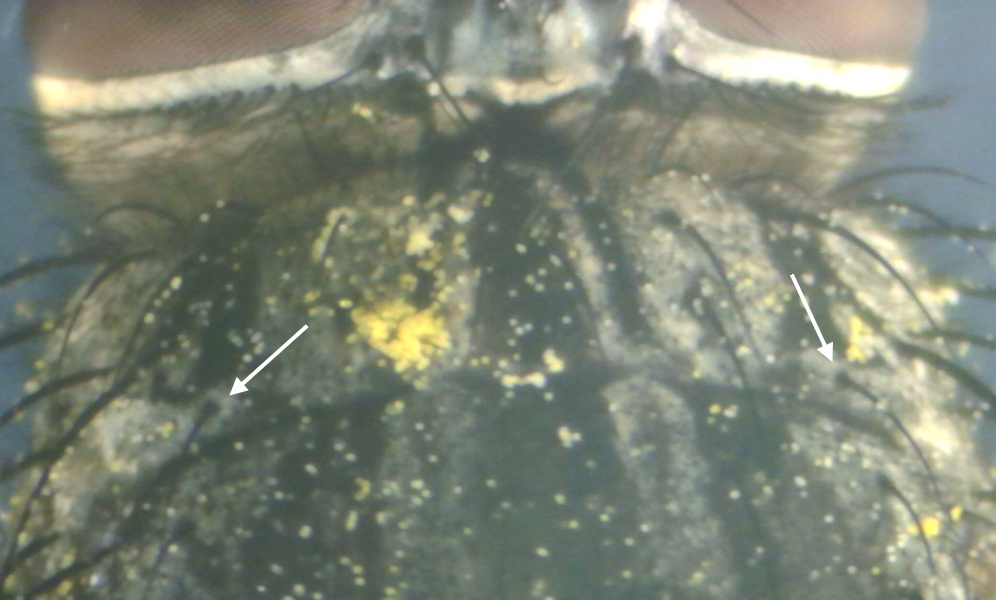Diptera.info :: Identification queries :: Diptera (adults)
Who is here? 1 guest(s)
Page 2 of 2: 12
|
|
odd growth on face = sticky substance
|
|
| Paul Beuk |
Posted on 12-09-2017 12:31
|
|
Super Administrator Location: Netherlands Posts: 19403 Joined: 11.05.04 |
There are four German species of Onesia...
Paul - - - - Paul Beuk on https://diptera.info |
| Paul Beuk |
Posted on 12-09-2017 12:38
|
|
Super Administrator Location: Netherlands Posts: 19403 Joined: 11.05.04 |
A paper on Onesia of 1964 by Schumann: http://contributi...d/686/685/
Paul - - - - Paul Beuk on https://diptera.info |
| johnes81 |
Posted on 12-09-2017 20:51
|
|
Member Location: Berlin, Germany Posts: 1980 Joined: 15.10.16 |
Thank You for the link Sir Paul. Fantastic paper! I tried to find this document before but I couldn't seem to find it using Google. Suddenly it appears in Google searches. Interesting. Thank You very much. I will still post some photos for you to see. I have three specimens which look similar. One I figure should be Onesia floralis but the hairs on the ovipositor look slightly different than the drawings in the book. The second one looks more like Bellardia, which makes me wonder if it is a different Onesia species. The third is the one here with the deformed spermatheca. Anyway, this document should help alot. I have separate lists of all diptera for Germany (in text files.) I also look at the red lists for Berlin to determine what is supposed to be recorded for Berlin. Only Onesia floralis is listed for Berlin but I suspect that one of these specimens should be austriaca. The paper by Schumann is a major boost in research. You are Wonderful Sir Paul. Thank You. John and Nini. Naturalists not experts. |
|
|
|
| johnes81 |
Posted on 12-09-2017 20:57
|
|
Member Location: Berlin, Germany Posts: 1980 Joined: 15.10.16 |
this first photo is from the fly in this post with the deformities. The ovipositor is not matching Onesia floralis. I wonder if the ovipositor is deformed/abnormal too? dorsal sclerites (still attached to the abdomen) Edited by johnes81 on 03-10-2017 10:49 John and Nini. Naturalists not experts. |
|
|
|
| johnes81 |
Posted on 12-09-2017 20:58
|
|
Member Location: Berlin, Germany Posts: 1980 Joined: 15.10.16 |
ventral sclerites of the same species (still attached to the abdomen):
Edited by johnes81 on 03-10-2017 10:49 John and Nini. Naturalists not experts. |
|
|
|
| johnes81 |
Posted on 12-09-2017 21:01
|
|
Member Location: Berlin, Germany Posts: 1980 Joined: 15.10.16 |
this photo is from the first species of three. This one most resembles Onesia floralis but the bristles and hairs don't match the drawings of Dr. Rognes. I wonder if this is austriaca. The paper that you have provided should help determine this species. Otherwise, I may have to consider Bellardia vulgaris. I will try to key it with both Schumann and Rognes.
Edited by johnes81 on 03-10-2017 10:49 John and Nini. Naturalists not experts. |
|
|
|
| johnes81 |
Posted on 12-09-2017 21:03
|
|
Member Location: Berlin, Germany Posts: 1980 Joined: 15.10.16 |
these are the spermathecae from the same fly which resembles Onesia floralis (species 1 of 3). I've erroneously typed a positive for floralis in this image. please disregard this note. I meant to type "spermathecae most matches floralis" Edited by johnes81 on 03-10-2017 10:48 John and Nini. Naturalists not experts. |
|
|
|
| johnes81 |
Posted on 12-09-2017 21:05
|
|
Member Location: Berlin, Germany Posts: 1980 Joined: 15.10.16 |
this photo shows the presutural ia of species 3 (the deformed fly of this post). Dr. Rognes writes that weak prst ia are possible but I don't think that these hairs/bristles are weak. Besides, the ovipositor doesn't match Onesia floralis.
johnes81 attached the following image:  [181.01Kb] John and Nini. Naturalists not experts. |
|
|
|
| johnes81 |
Posted on 03-10-2017 10:52
|
|
Member Location: Berlin, Germany Posts: 1980 Joined: 15.10.16 |
Update: Sir Paul is correct about the ptilinium. Dr. Rognes states the following regarding this species: "Newly hatched, note the exposed, not withdrawn ptilinium". Further, my Wife and I deduced that these should be Onesia austriaca which is not recorded in Berlin. Dr. Rognes has confirmed that all three species are in fact Onesia austriaca. So we have a first record for Berlin. And now I know what Onesia austriaca looks like. John and Nini. Naturalists not experts. |
|
|
|
Page 2 of 2: 12
| Jump to Forum: |













